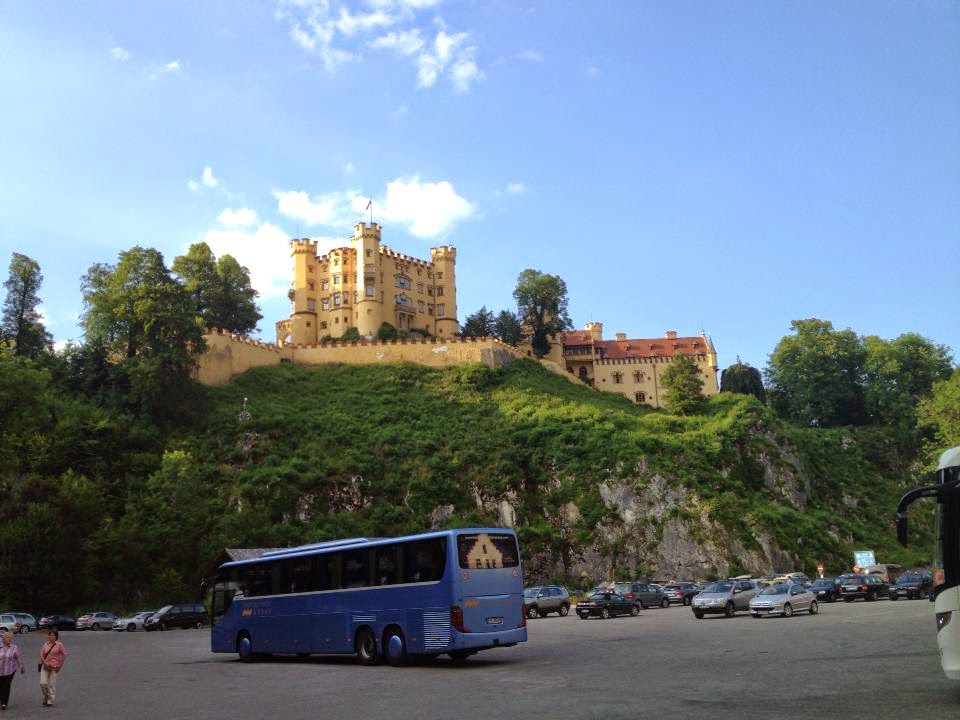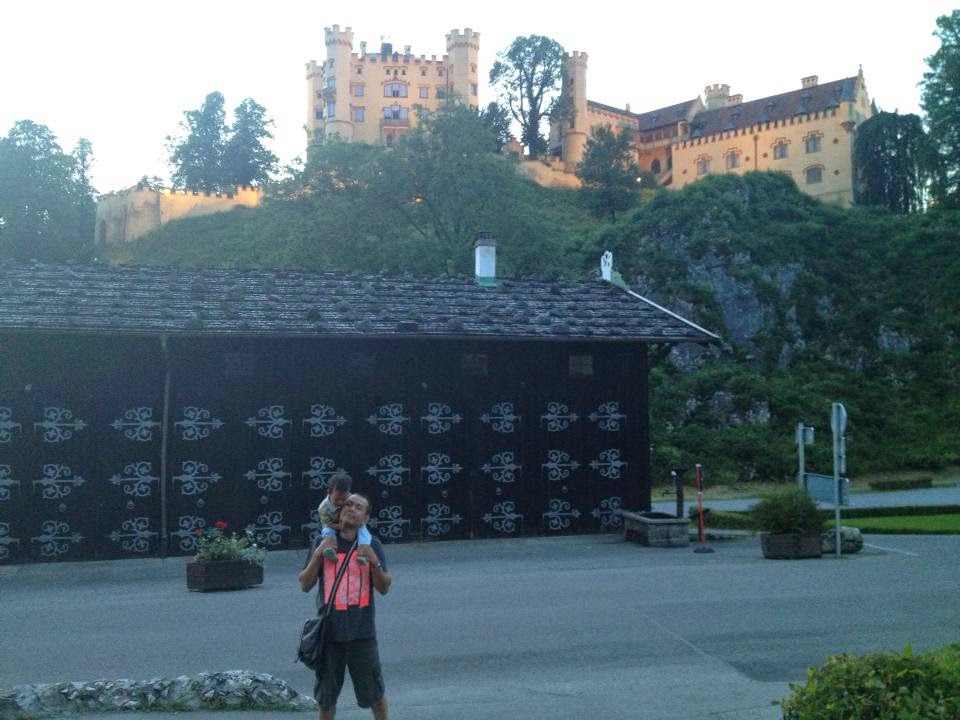Schwangau is a municipality in the district of Ostallgäu in Bavaria, Germany. The village lies 4 km from the larger town of Füssen and just 1.5 km from Hohenschwangau, a collection of tourist-oriented facilities adjacent to the major tourist attractions of Schloss Neuschwanstein and Schloss Hohenschwangau.
Schwangau has no railway station, but is served by buses connecting to Füssen, Hohenschwangau, and other nearby Alpine towns. It is the next-to-last town on the Romantic Road tourist route that terminates in Füssen.
A castrum Swangowe is attested in 1090. It was situated on the site of Neuschwanstein Castle and was owned by the Elder House of Welf. After the death of Welf VI in 1191, it fell to the Staufer dynasty, and in 1268 to the empire. The modern coat of arms is based on the one shown in the Codex Manesse as that of Hiltpolt of Schwangau, gules, a swan argent.
geography
Expansion of the municipal area
The municipality consists of the districts Schwangau and Waltenhofen. The municipality of Schwangau include the places Schwangau, Alterschrofen, fountains, Erlisholz, Hohenschwangau, Horn, and Miihlberg Waltenhofen (there is always been the parish church). The municipal area are the Alpseestrasse, the swan lake and the spell Waldsee. Also features the largest (eastern) part of the Forggensee to the community.
history
Tool finds on the mountain woman with horn and on the north bank of the Bann forest lake suggest that the first settlement Schwangau dating back to the Middle Stone Age.
In the year 15 v. Chr. Conquered Roman troops under Drusus and Tiberius the Alps to the Danube River. Under Emperor Claudius probably already existing as a path Alpenweg was in a five-meter wide road, the Via Claudia Augusta, expanded. She joined the Roman province of Raetia to the mother country. In Füssen a replenishment unit was at that time stationed. Disused soldiers received as a parting gift from the military small estates and went with the local population communities a.
So the Roman settlement arose at Tegel mountain with a conserved today bathhouse dating from the 2nd century and the small "villae rusticae" (estates) in Forggen. In the years 284-305 German tribes overran the country several times and left it with the collapse of the Roman Empire - presumably peacefully - to the 450th
The Alemanni settled the Schwangau region around the year 600 and farmed it. It is believed that they moved lech up and then began to clear in Schwangau. From that time until today, about 130 graves on the northern edge of Schwangau receive.
With the beginning of Christianity in the 8th century, then missing in the graves grave goods, so that can only be speculated about the whereabouts of the Alemanni. In this time the foundation of the church falls in Waltenhofen in 746. She was the first Christian church on the right of the Lech and was built by the Holy Magnus and Tosso.
The first mention of Schwangau as "Castrum Swangowe" took place in 1090. Thus, the double castle front and rear Schwangau was meant, on the rock of today's castle Neuschwanstein. She was the property of the elder Welf. The Guelph Ministerialen (ds administrator in the low nobility), the Schwangau, lived on this swan stone. With the death of Welf VI. 1191 drops the Guelph ownership of Schwangau at the Staufer, 1268 to the Reich.
At this time, the most famous of Schwangau, The Minstrel Hiltbolt of Schwangau lived (ca. 1190-1256 *). From him 22 Minnelieder are obtained, the formation time is set from 1215 to 1225, who found in the Heidelberg and partly in the Weingartner song manuscript collection.
From the 15th century, with the division of power by Ulrich von Schwangau on his four sons in 1428, came the Schwangau, who had now risen to knighthood, from their financial distress not get out. Mismanagement and inheritance disputes led to Georg von Schwangau his inheritance, Hohenschwangau and the woman stone, as well as the jurisdiction to to Duke Albrecht III. sold by Bayern Munich in 1440. The Schwangau were now mostly the ATTNDT the Dukes of Bavaria to Schwangau.
1521, the two brothers Heinrich and Georg von Schwangau were invested at the Diet of Worms with the Alloden and fief by Emperor Charles V of Schwangau. But already in 1535 they had to sell the entire property for 35,000 fl. To the Imperial Council and patrician Johann Paumgartner from Augsburg. In 1536 the two brothers died, and so died the family of the Lords of Schwangau.
Johann Paumgartner had neglected to build the castle swan stone (now Castle Hohenschwangau) again, while front and rear Schwangau and Mrs Stone still neglected. Johann died in 1549 Paumgartner and the rule fell to his two sons David and George. 1561 pledged David Paumgartner Hohenschwangau to Margrave Georg Friedrich of Brandenburg-Ansbach-Kulmbach.
The Marquis sold the rule in 1567 to Duke Albrecht V of Bavaria. This also brought the claims of creditors Paumgartners itself and became rich legally invested with Hohenschwangau. 1604 then received Duke Maximilian I of Bavaria connected with the reversion of the Hohenschwangau fiefdom, Elector Ferdinand Maria of Bavaria in 1670 it yourself.
The turmoil of the Thirty Years' War (1618-1648) came to Schwangau another tribulation added: the plague. They raged in the years 1635/1636 and decimated the population strong. During the night the dead were moved on carts out to the plague cemetery to St. Coloman. After this great bloodletting the community was repopulated with immigrants from Austria and from the Engadine. Of the latter probably comes the typical construction of Schwangau, "the Schupfe".
In the following decades, the castle changed in Hohenschwangau owners several times. During the Napoleonic Wars 1800-1809 she was so badly damaged that they could be sold in 1820 only as a ruin. Acquired 1832 Crown Prince Maximilian, later King Max II., The ruins and had them according to the plans and sketches of Dominicus Quaglio in the Gothic Revival style built again (1832-1836).
The eldest son Maximilian, Ludwig II. Of Bavaria had, build the Neuschwanstein castle on the site of castles front and rear Schwangau. The foundation stone was laid on September 5, 1869. The construction work was set in 1886 with the death of the king, so that the castle was never fully completed.
Shortly before the turn of the century, tourism in Schwangau collection and the first inns and HOTELS held arisen. As a result of this development, the population turned increasingly sensitive to tourism. 1938 has been built under the then mayor Pfeiffer in Schwangau a park.
Many efforts of the community over the years led to the recognition in 1926 as a health resort and in 1986 the award of the predicate climatic health resort.
The damming of the Forggensee 1953/1954 meant a great structural change for the community. Thus, the church lost 1,071 hectares of land, a quarter of its former area. The Villages Dettenhausen, Froggen and parts of Fountain fell victim to the impoundment. With the support of BAWAG (Bayerische hydropower AG) were the municipal water supply, a part of the local sewer system, the primary school and the town hall FINANCED be.
My family loved to travel .... If possible, my family will travel around the world. My Travel and Tourism ... travel,reise,photo,foto,my travel,meinereise,reisen,Urlaub,Holiday , my photo gallery . mein Foto Galerie
Subscribe to:
Post Comments (Atom)
Chiang Khan
slogan: Chiang Khan, the city of beautiful people, long-grained rice, glass coconuts, beautiful islands and pristine islands cultural site ...

-
Sukhothai (Thai: สุโขทัย) is one of the northern provinces (changwat) of Thailand. Neighboring provinces are Phrae, Uttaradit, Phitsanulok, ...
-
02.06.2021 Aktuelles In Deutschland haben mittlerweile 50 Prozent aller Erwachsenen die erste Schutzimpfung gegen das Coronavirus erhalten. ...
-
Ayutthaya Wangchgag the corral , Ayutthaya Elephant Palace & Royal Kraal, Ayutthaya Elephant Camp WANG Ayutthaya Ayutthaya Eleph...

















.jpg)

























No comments:
Post a Comment